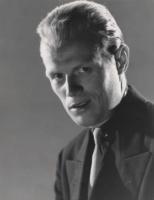
Human Monsters[ Book Contents]
Peeping Tom [Michael Powell, 1960]
Carl Boehm and Anna Massey in this study of a psychotic voyeur. A movie so disturbing it basically ended Powell’s career.
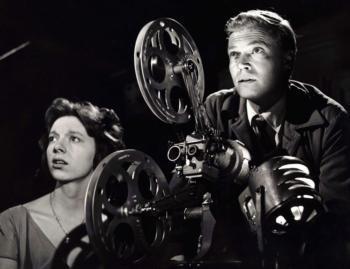
Human Monsters[ Book Contents]
Jack the Ripper [Robert S. Baker, Monty Berman, 1959]
A straightforward account of Britain’s most infamous serial killer. Considered very brutal when it was released, its violence is rather tame for today’s jaded audience.

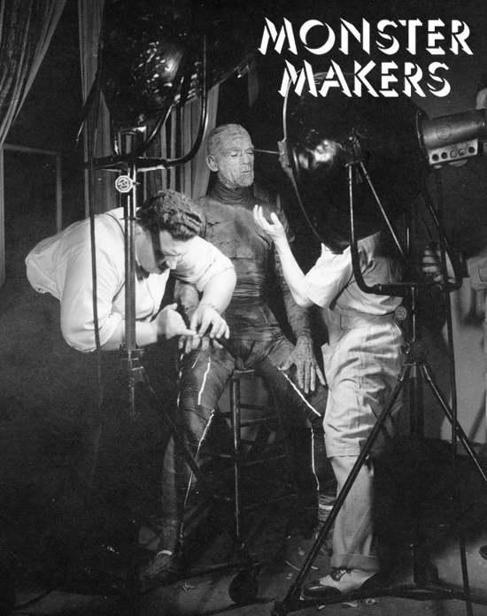
Putting finishing toucheson Boris Karloff’s costume and make-up for The Mummy[Karl Freund, 1932].
MONSTER MAKERS
From the earliest days of the Nickelodeons, filmmakers have consistently invented new techniques to help us “suspend our disbelief.”
The French filmmaking pioneer Georges Méliès was one of the first to use the camera to create visual effects. By pausing in turning the hand crank on his camera for a moment, Méliès was able to make people and objects appear and disappear as if by magic.
Linwood G. Dunn’s work in the 1920s perfected the optical printer, revolutionizing optical effects. Literally a camera set up to re-photograph already exposed film, creating multiple layers of images onto a negative, the optical printer enabled the movies to present astonishing compositions on screen. One of the greatest creators of “optical effects” was John P. Fulton, whose innovative and stunning work on The Invisible Man[James Whale, 1933] still dazzles the eye. My favorite of Fulton’s effects are the homunculi Dr. Pretorius so proudly displays in The Bride of Frankenstein[James Whale, 1935].
Building sets and vehicles to a much smaller scale allowed scenes of breathtaking destruction to be shot with minimal cost and danger. “Miniature” car crashes, airplanes, explosions, volcanoes, rocket ships, and more, have all been constructed on a stage or back lot to help visualize story elements that would have been impractical to recreate full size. Master miniature makers include the legendary Lydecker Brothers, Howard and Theodore. The Lydecker Brothers were on staff at Republic Pictures and worked on such classic serials as Adventures of Captain Marvel[1941], and Commander Cody: Sky Marshal of the Universe[aka Radar Men From The Moon, 1952-3]. Japanese master Eiji Tsuburaya was the resident special FX go-to guy for Toho Studios. Tsuburaya’s work is seen in almost every Godzillafilm. Derek Meddings started work on the Gerry and Sylvia Anderson puppet TV shows like Fireball XL5[1962] and Thunderbirds[1965-66]. Derek went on to do the miniatures on Superman[Richard Donner, 1978] and for the James Bond pictures The Man with the Golden Gun[Guy Hamilton, 1974] and The Spy Who Loved Me[Lewis Gilbert, 1977].
Greg Jein built the iconic miniature of the Death Star for Star Wars[George Lucas, 1977], and the aliens’ mother ship for Close Encounters of the Third Kind[Steven Spielberg, 1977].
Matte painters like Albert Whitlock, Harrison Ellenshaw, Peter Ellenshaw, Norman Dawn, and Matthew Yuricich created remarkable illusions for movies with a paint brush and a pane of glass (see the illustrations given in the section Matte Painting).
The producer and director George Lucas and his crew at Industrial Light & Magic have brought movies into the digital age. Special effects in the movies will continue to evolve, but never forget that every movie you see, has been literally handmade.
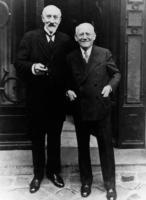
Two giants of the fantasy film:Georges Méliès and Carl Laemmle meet in Paris. Méliès is the father of special effects; Laemmle was one of the founders of Universal Pictures, the studio that produced most of the classic monster movies.
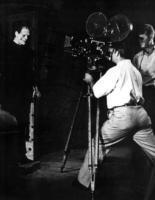
Shooting a close-upof Boris Karloff as the Monster in Frankenstein[James Whale, 1931].
The Monster Makers[ Book Contents]
Creature From the Black Lagoon [Jack Arnold, 1954]
Bob Dawn (white shirt), Robert Hickman (kneeling), and Jack Kevan (black suit) adjust the Gill-Man costume on Ben Chapman (Ricou Browning did the underwater swimming in Florida). Universal’s head of make-up Bud Westmore got sole screen credit, but Jack Kevan did most of the work.
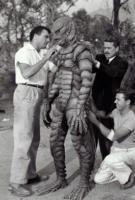
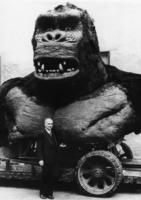
Willis O’Brienposes with the full-size head used for close-ups in King Kong[Cooper, Schoedsack, 1933].
MONSTER DIRECTORS
James Whale, Tod Browning, George A. Romero, William Castle, and Jack Arnold are five directors whose monster movies have had lasting impact and influence. Between them, they have brought us Dracula, Frankenstein, Night of the Living Dead, The Tingler, Creature From the Black Lagoon, The Mummy, The Incredible Shrinking Man, and many more classic movie monsters!
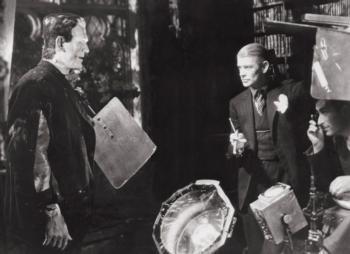
Boris Karloffas the Monster is scrutinized by well-dressed director James Whale and cameraman John J. Mescall on the set of The Bride of Frankenstein[1935]. The elegant Whale never failed to inject an element of camp into all of his horror films.
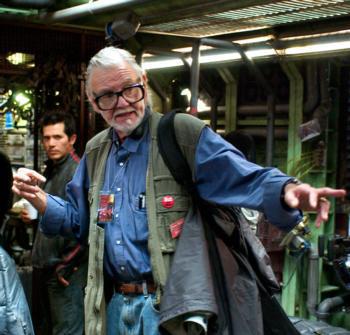
George A. Romeropoints to where some new zombie atrocity will take place on the set of Land of the Dead[2005]. Romero has single-handedly made the zombie themonster of the 21st Century.
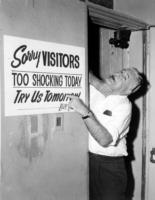
William Castlein a gag photo at the sound stage door of one of his many thrillers. Castle often used carny-style gimmicks to sell his movies to the public.
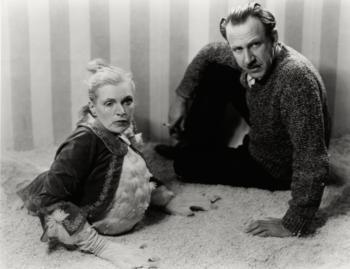
Tod Browningon set with Olga Baclanova, who played the beautiful, cruel trapeze artist in Freaks[1932]. Baclanova is in costume and make-up as the pathetic sideshow freak her character becomes in the film’s gruesome climax.
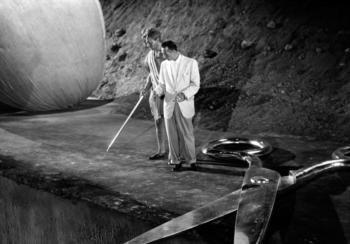
Jack Arnold(white jacket) with actor Grant Williams on the set of The Incredible Shrinking Man[1957]. Both director and star are dwarfed by the giant set and props used to create the illusion of the lead character’s tiny size.
MAKE-UP ARTISTS
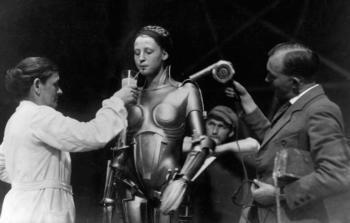
On the set of Metropolis,[Fritz Lang, 1927], make-up and costume personnel attend to Brigitte Helm in most of her costume as the robot Maria.
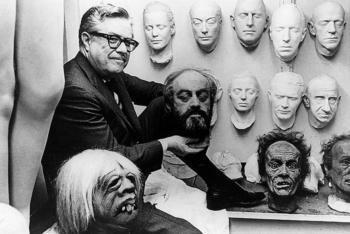
William Tuttlesupervised the make-up on The Wizard of Oz[1939] eventually replacing Jack Dawn as Head of Make-up at MGM. In this photo can be seen a Morlock mask from The Time Machine[1960] and a head used in The Picture of Dorian Gray[1945], as well as life masks of MGM stars. Tuttle received an honorary Academy Award for 7 Faces of Dr. Lao[1964].